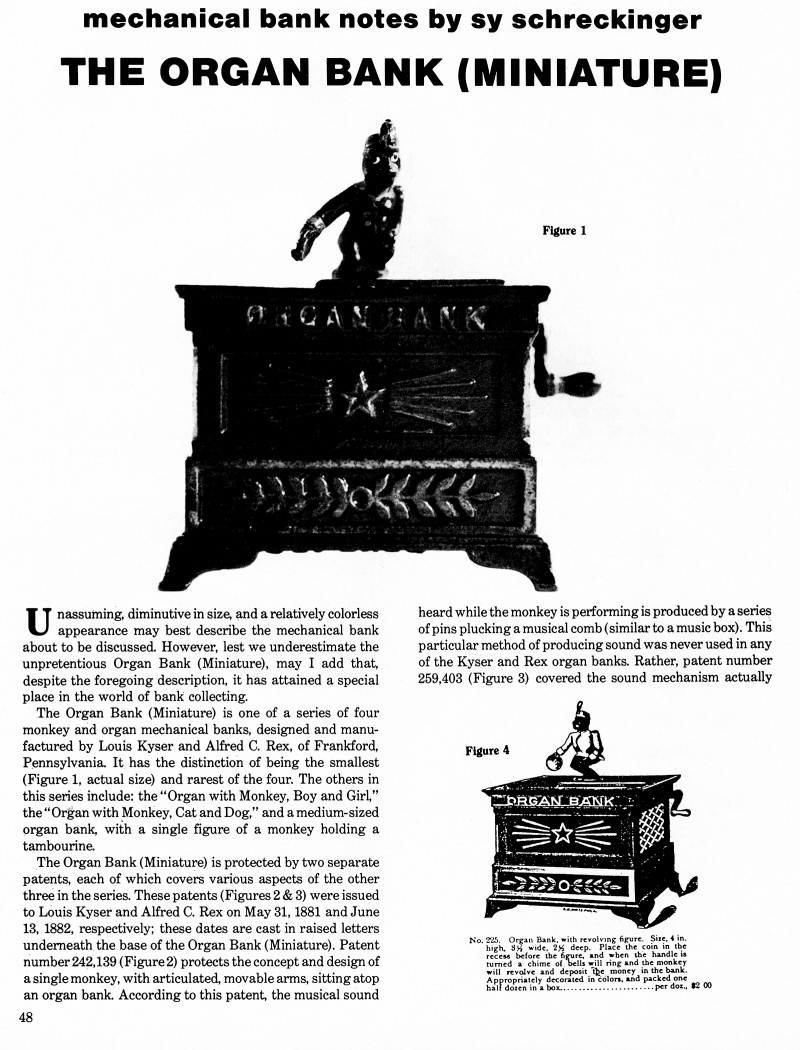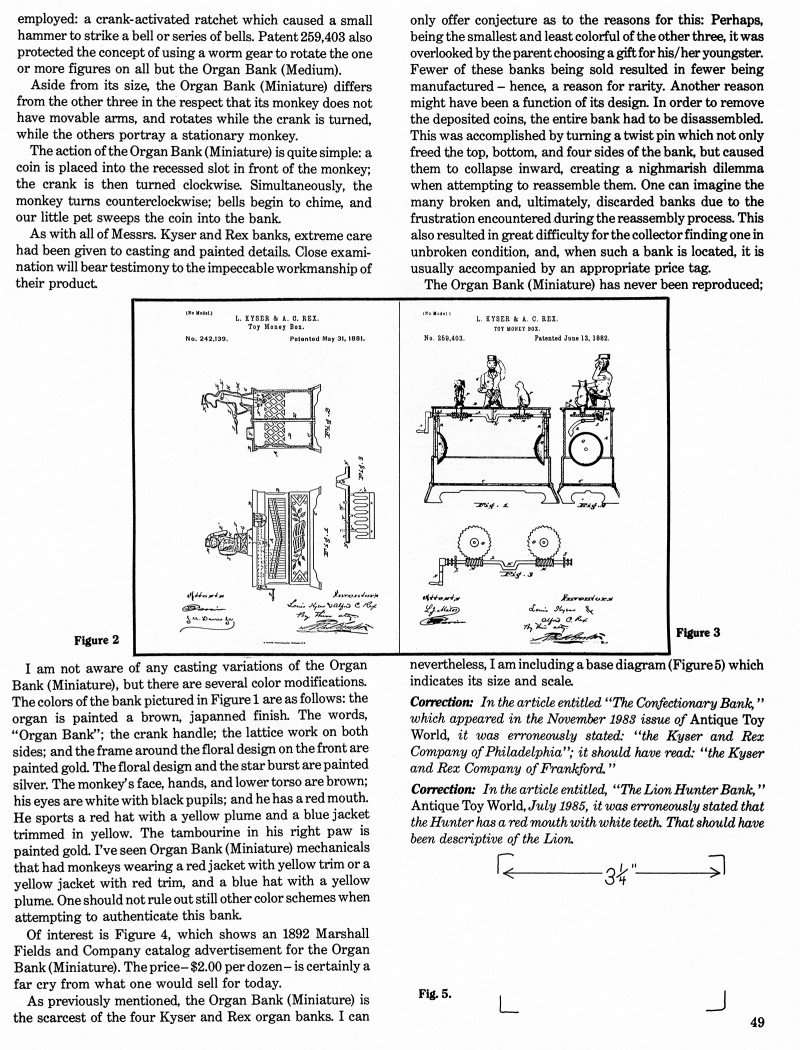|
The
Organ Bank (Miniature)
by Sy Schreckinger – ANTIQUE TOY WORLD Magazine – September,
1985
Unassuming, diminutive in size, and a relatively
colorless appearance may best describe the mechanical bank about to be
discussed. However, lest we underestimate the unpretentious Organ Bank
(Miniature), may I add that, despite the foregoing description, it has
attained a special place in the world of bank collecting.
The Organ Bank (Miniature) is one of a series of four monkey and
organ mechanical banks, designed and manufactured by Louis Kyser and
Alfred C. Rex, of Frankford, Pennsylvania. It has the distinction of being
the smallest (Figure 1, actual size) and rarest of the four. The others in
this series include: the "Organ with Monkey, Boy and Girl," the "Organ
with Monkey, Cat and Dog," and a medium-sized organ bank with a single
figure of a monkey holding a tambourine.
The Organ Bank (Miniature) is protected by two separate patents, each of
which covers various aspects of the other three in the series. These
patents (Figures 2 & 3) were issued to Louis Kyser and Alfred C. Rex on May
31, 1881 and June 13, 1882, respectively; these dates are cast in raised
letters underneath the base of the Organ Bank (Miniature). Patent number
242,139 ( Figure 2) protects the concept and design of a single monkey,
with articulated, movable arms. sitting atop an organ bank. According to
this patent, the musical sound heard while the monkey is performing is
produced by a series of pins plucking a musical comb (similar to a music
box). This particular method of producing sound was never used in any of
the Kyser and Rex organ banks. Rather, patent number
259,403 (Figure 3)
covered the sound mechanism actually employed: a crank-activated ratchet
which caused a small hammer to strike a bell or series of bells. Patent
259,403 also protected the concept of using a worm gear to rotate the one
or more figures on all but the Organ Bank (Medium).
Aside from its size, the Organ Bank (Miniature) differs from the
other three in the respect that its monkey does not have movable arms, and
rotates while the crank is turned, while the others portray a stationary
monkey.
The action of the Organ Bank( Miniature) is quite simple: a coin is
placed into the recessed slot in front of the monkey; the crank is then
turned clockwise Simultaneously, the monkey turns counterclockwise; bells
begin to chime, and our little pet sweeps the coin into the bank.
As with all of Messrs. Kyser and Rex banks, extreme care had been
given to casting and painted details. Close examination will bear
testimony to the impeccable workmanship of their product.
I am not aware of any casting variations of the Organ Bank
(Miniature), but there are several color modifications. The colors of the
bank pictured in Figure 1 are as follows: the organ is painted a brown,
japanned finish. The words, "Organ Bank"; the crank handle; the lattice
work on both sides; and the frame around the floral design on the front
are painted gold. The floral design and the star burst are painted silver.
The monkey's face, hands, and lower torso are brown; his eyes are white
with black pupils; and he has a red mouth. He sports a red hat with a
yellow plume and a blue jacket trimmed in yellow. The tambourine in his
right paw is painted gold. I've seen Organ Bank (Miniature) mechanicals
that had monkeys wearing a red jacket with yellow trim or a yellow jacket
with red trim, and a blue hat with a yellow plume. One should not rule out
still other color schemes when attempting to authenticate this bank.
Of interest is Figure 4, which shows an 1892 Marshall Fields and
Company catalog advertisement for the Organ Bank (Miniature). The price –
$2.00 per dozen – is certainly a far cry from what one would sell for
today.
As previously mentioned, the Organ Bank (Miniature) is the scarcest
of the four Kyser and Rex organ banks. I can only offer conjecture as to
the reasons for this: Perhaps, being the smallest and least colorful of
the other three it was overlooked by the parent choosing a gift for
his/her youngster. Fewer of these banks being sold resulted in fewer being
manufactured – hence, a reason for rarity. Another reason might have been
a function of its design. In order to remove the deposited coins, the
entire bank had to be disassembled. This was accomplished by turning a
twist pin which not only freed the top, bottom, and four sides of the
bank, but caused them to collapse inward, creating a nighmarish dilemma
when attempting to reassemble them. One can imagine the many broken and,
ultimately, discarded banks due to the frustration encountered during the
reassembly process. This also resulted in great difficulty for the
collector finding one in unbroken condition, and, when such a bank is
located, it is usually accompanied by an appropriate price tag.
The Organ Bank (Miniature) has never been reproduced; nevertheless, I am
including abase diagram Figure5 which indicates its size and scale.
Correction: In the article entitled "The Confectionary Bank," which
appeared in the November 1983 issue of Antique Toy World, it was
erroneously stated: "the Kyser and Rex Company of Philadelphia"; it should
have read; "the Kyser and Rex Company of Frankford."
Correction: In the article entitled, "The Lion Hunter Bank," Antique
Toy World, July 1985, it was erroneously stated that the Hunter has a red
mouth with white teeth. That should have been descriptive of the Lion.
Correction: (from
November, 1985) Referring to the
September 1985 issue of Antique Toy
World magazine, the photograph of the Organ Tiny bank was erroneously
represented as actual size. The actual bank is smaller than the
photograph. Please refer to the base diagram pictured in that article for
the correct dimension.
Correction: (from
February, 1986) In the article entitled, "Organ Bank (Miniature),"
which appeared in the September 1985 issue of Antique Toy World, it was
erroneously stated: "a medium-sized organ bank, with a single figure of a
monkey holding a tambourine. " It should have read: "a medium-sized organ
bank, with a single figure of a monkey holding a round tray."
|


